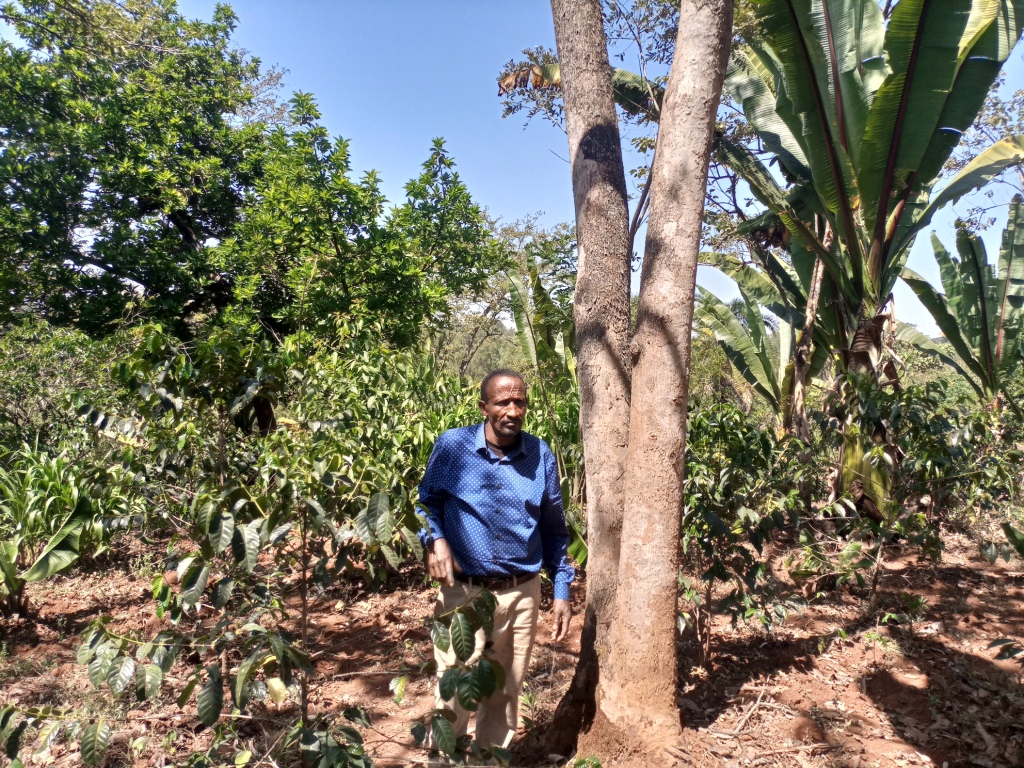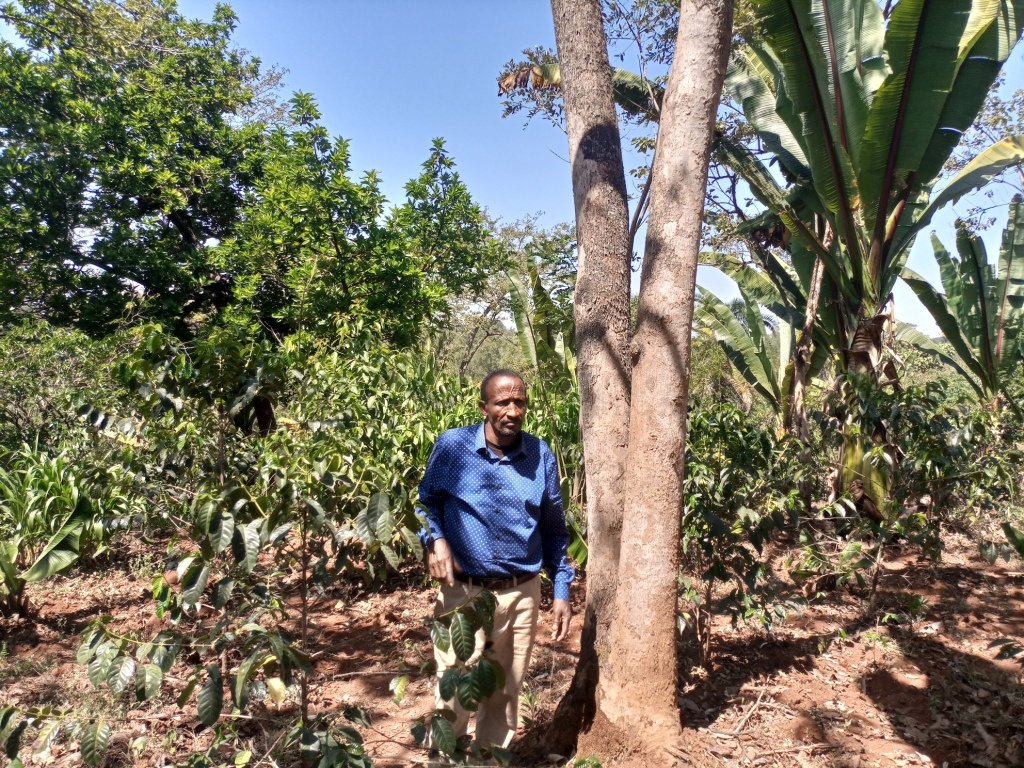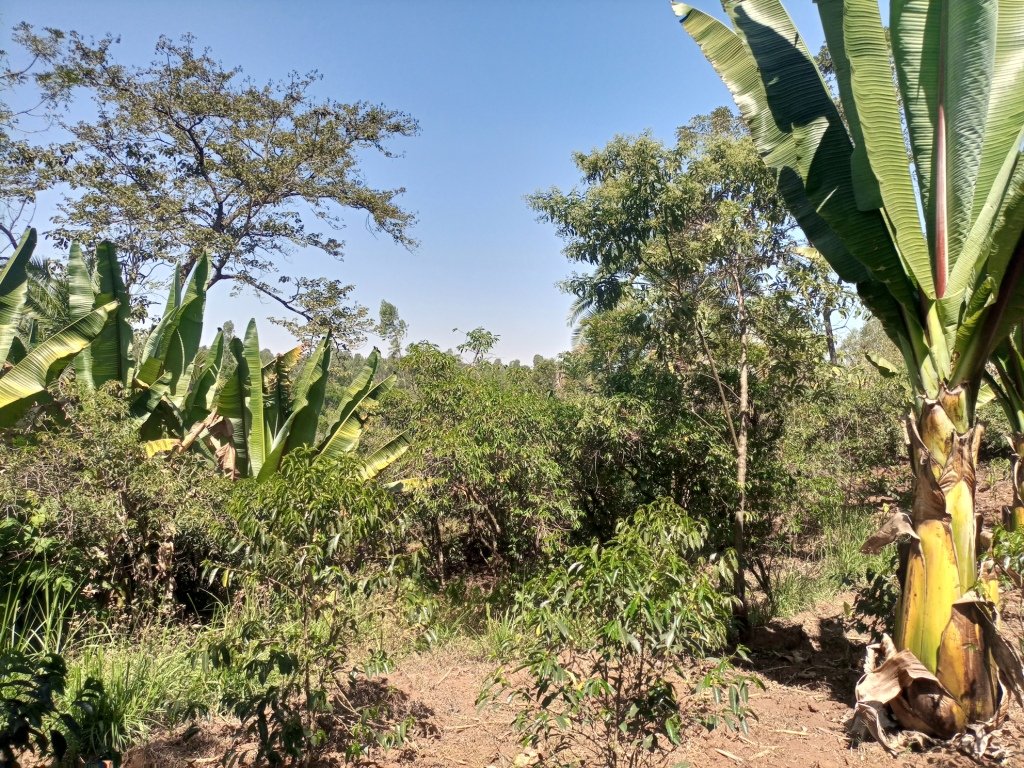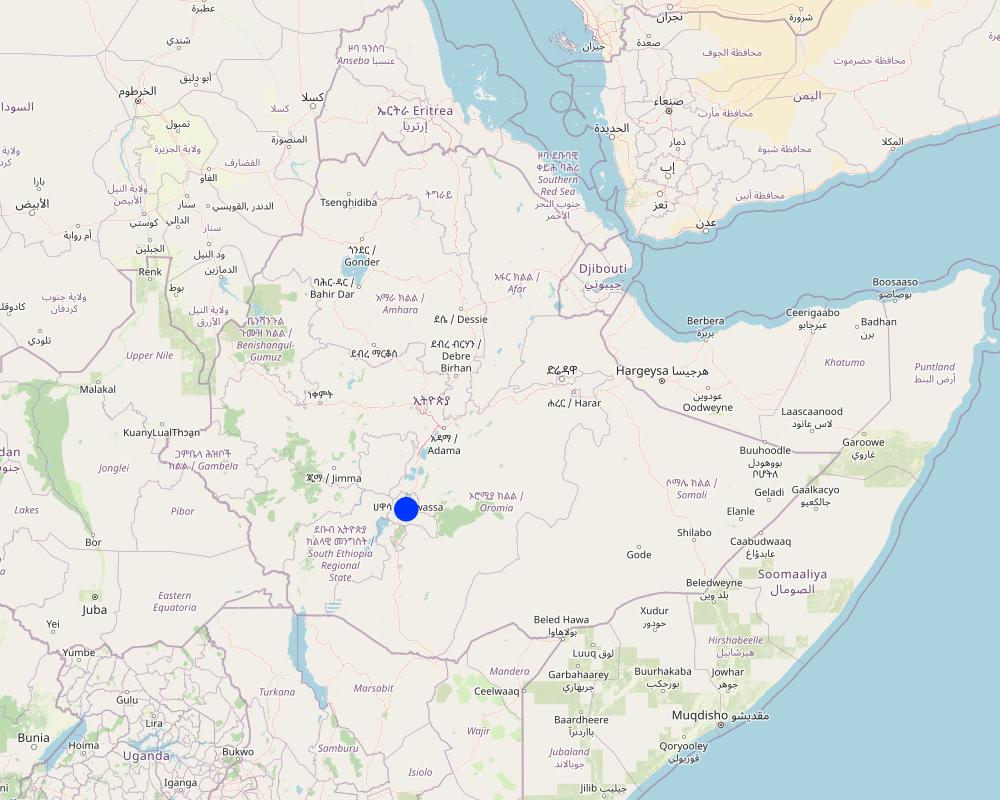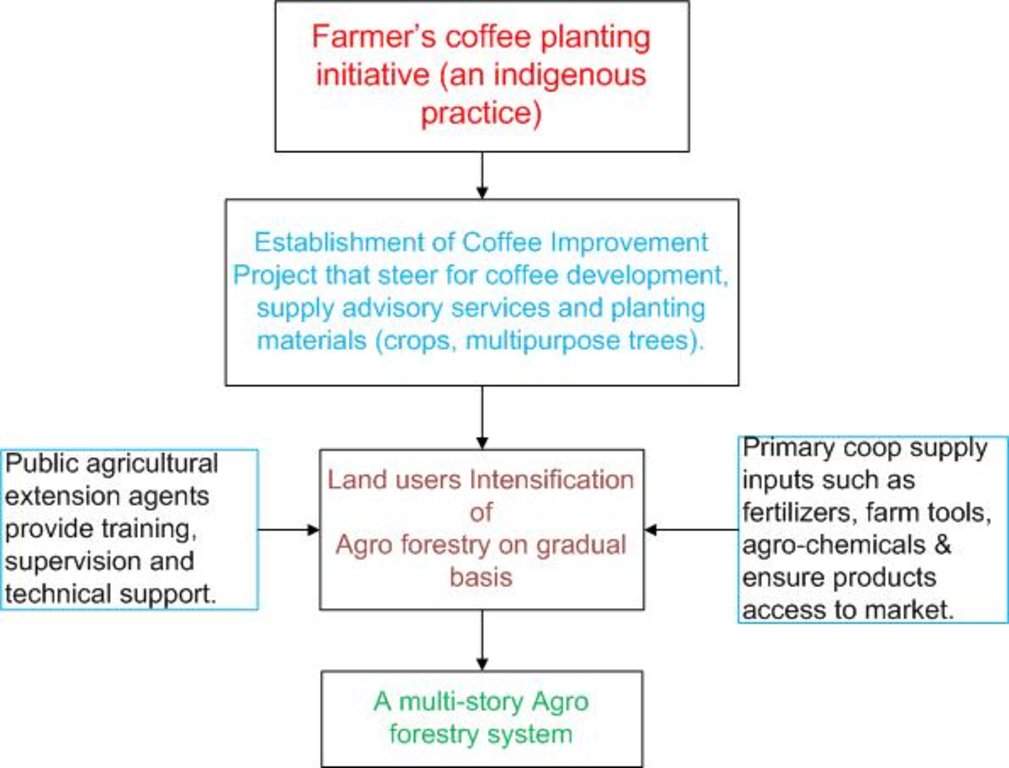Integrated Agroforestry System [เอธิโอเปีย]
- ผู้สร้างสรรค์:
- การอัพเดท:
- ผู้รวบรวม: GERBA LETA
- ผู้เรียบเรียง: Julia Doldt, Noel Templer, Kidist Yilma, Tabitha Nekesa, Ahmadou Gaye, Siagbé Golli
- ผู้ตรวจสอบ: William Critchley, Rima Mekdaschi Studer, Sally Bunning
Mitikarsamino Ersha
approaches_6622 - เอธิโอเปีย
ดูส่วนย่อย
ขยายทั้งหมด ย่อทั้งหมด1. ข้อมูลทั่วไป
1.2 รายละเอียดที่ติดต่อได้ของผู้รวบรวมและองค์กรที่เกี่ยวข้องในการประเมินและการจัดเตรียมทำเอกสารของแนวทาง
วิทยากรหลัก
ผู้ใช้ที่ดิน:
Gabiba Afra
+251 934 73 5738
Farmer
Dale District, Shoye kebele Sidma Regional State Ethiopia
เอธิโอเปีย
ชื่อของโครงการซึ่งอำนวยความสะดวกในการทำเอกสารหรือการประเมินแนวทาง (ถ้าเกี่ยวข้อง)
Soil protection and rehabilitation for food security (ProSo(i)l)ชื่อของโครงการซึ่งอำนวยความสะดวกในการทำเอกสารหรือการประเมินแนวทาง (ถ้าเกี่ยวข้อง)
CIAT International Center for Tropical Agriculture (CIAT International Center for Tropical Agriculture) - เคนยา1.3 เงื่อนไขที่เกี่ยวข้องกับการใช้ข้อมูลที่ได้บันทึกไว้ผ่านทาง WOCAT
วันที่เก็บรวบรวมข้อมูล (ภาคสนาม):
13/01/2023
ผู้รวบรวมและวิทยากรหลักยอมรับเงื่อนไขเกี่ยวกับการใช้ข้อมูลที่ถูกบันทึกผ่านทาง WOCAT:
ใช่
1.4 การอ้างอิงถึงแบบสอบถามเรื่องเทคโนโลยี SLM
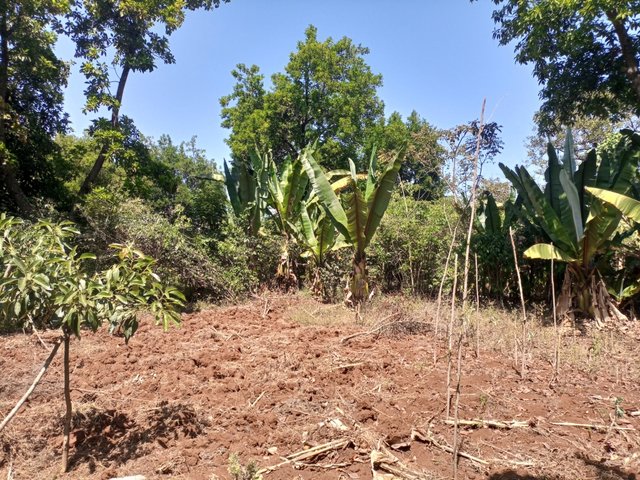
Multistorey agroforestry [เอธิโอเปีย]
Multistorey agroforestry is the intentional mixing of trees/shrubs with crops, pastures, and livestock. The practice creates environmental, economic, and social benefits for the end users.
- ผู้รวบรวม: GERBA LETA
2. คำอธิบายของแนวทาง SLM
2.1 การอธิบายแบบสั้น ๆ ของแนวทาง
The integrated agroforestry system is a self-initiated approach by a land user to implement agroforestry as part of an indigenous practice and has evolved over the years through technical support, training, and supplies of coffee and tree seedlings by the Office of Agriculture and Coffee Improvement Project. Had there been a participatory process throughout it would have helped in design and also in scaling up.
2.2 การอธิบายอย่างละเอียดของแนวทาง
การอธิบายอย่างละเอียดของแนวทาง:
The integrated agroforestry system was independently initiated by land users during the Derg regime (1974-91). During the regime, farmers were failed by two distinct and polar development approaches: socialist and the mainstream local approaches. The earlier one involved the communist approach of communal production and sharing the output according to contribution. The latter ones employed a conventional approach and included non-members of the so-called Farmers Producer Cooperatives. As a non-member of the earlier one, the land user had to develop his farm alone. The solitary agroforestry initiative described here has gradually evolved to a fully-fledged system that currently serves as a model SLM practice for scaling up across similar agroecological and farming system. Thus, there was little participation involved during the early intensification of agroforestry in Ethiopia. Rather, it is considered an indigenous practice that now receives publicity as a form of “regenerative agriculture” with ecological, economic, and social benefits. As it has global significance in terms of emission reduction and sequestration of carbon, it is the favourite technology among the government and other development practitioners.
The farmer started agroforestry by planting enset and coffee. Over time, with emerging technical support, access to training, and supply of coffee seedlings by the agriculture and coffee improvement project offices, the land user has continued intensification of the agroforestry around the homestead by adopting the correct planting space for coffee and enset, and other companion fruit, fodder crops, and shade trees. The former Ministry of Coffee and Tea, and the current Ministry of Agriculture have had an immense contribution by supplying technical support, training, and inputs (notably coffee and tree seedlings), and by ensuring access to fertilizers. The latter was supplied to the farmers on a credit basis through the then Service Cooperative.
As the initiative was the farmer's own, the tendency to plant incompatible crops was not uncommon. Even so, the agroforestry trees and shrubs still had immense ecological and economic value. They ameliorate the extreme temperature experienced during the dry season, improve the microclimate, recharge the surface and groundwater via improving water infiltration, and reduce runoff losses. Improving soil fertility and soil health are among other benefits. Despite the substantial benefit the technology confers on land users, the lack of a participatory approach in planning, implementation, monitoring, and evaluation at the community level restricts the adoption and scaling up of this beneficial approach. Despite the achievements of the land user, earlier engagement of other smallholders and institutionalizing the approach decades ago might have positively influenced the design as well as wider-scale adoption and application of the technology. However, regardless of any limitations, the technology is evidence-based and inspirational.
2.3 รูปภาพของแนวทาง
ข้อสังเกตทั่วไปเกี่ยวกับรูปภาพ:
The photo shows the practice rather than the approach. However, the existing scene is just the outcome of the approach (farmer's own) employed to establish and maintain the agroforestry practice.
2.4 วีดีโอของแนวทาง
ความคิดเห็น อธิบายสั้นๆ:
Videos of the approach is not documented.
2.5 ประเทศ ภูมิภาค หรือสถานที่ตั้งที่ได้นำแนวทางไปใช้
ประเทศ:
เอธิโอเปีย
ภูมิภาค/รัฐ/จังหวัด: :
Sidama
ข้อมูลเฉพาะเพิ่มเติมของสถานที่ตั้ง:
Shoye kebele (Kebele - lower administrative level).
ความคิดเห็น:
As perennial crop enset (false banana) is a staple food in the area, the farming system is tree based but vary with degrees of intensification.
Map
×2.6 วันที่เริ่มต้นและสิ้นสุดของแนวทาง
ระบุปีที่เริ่ม:
1980
ความคิดเห็น:
It is a continuous, non-ending self initiative inheritable by the generation to come.
2.7 ประเภทของแนวทาง
- แบบดั้งเดิม/ แบบพื้นเมิอง
2.8 เป้าหมายหรือวัตถุประสงค์หลักของแนวทาง
A traditional approach was initiated to change the land use/ land cover and optimize the benefit of the degraded land by reducing the negative effects of overgrazing and its consequence.
2.9 เงื่อนไขที่เอื้ออำนวยหรือเป็นอุปสรรคต่อการนำเทคโนโลยีภายใต้แนวทางนี้ไปปฏิบัติใช้
บรรทัดฐานและค่านิยมทางสังคม วัฒนธรรม ศาสนา
- เอื้ออำนวย
The long-standing tradition of the society promotes planting and preserving trees.
การมีไว้ให้หรือการเข้าถึงแหล่งการเงินและบริการ
- เอื้ออำนวย
Access to in-kind credit services such as fertilizers from farmers' cooperatives enables the land users to effectively implement the practice.
การจัดตั้งระดับองค์กร
- เป็นอุปสรรค
The lack of institutional setting might have influenced the rate of scaling the technology.
การร่วมมือหรือการทำงานประสานกันของผู้ลงมือปฏิบัติ
- เอื้ออำนวย
Foster farmers access to training, technical support, exchange visit...
กรอบแนวทางในการดำเนินการด้านกฎหมาย (การถือครองที่ดิน สิทธิในการใช้ที่ดินและน้ำ)
- เอื้ออำนวย
Enables the development of a sense of ownership and accountability to properly implement and manage the practice.
ความรู้เกี่ยวกับ SLM การเข้าถึงการสนับสนุนด้านเทคนิค
- เอื้ออำนวย
Promote effective implementation, management, and use of the return from the practice.
ตลาด (จัดซื้อปัจจัยนำเข้า ขายผลิตภัณฑ์) และราคา
- เอื้ออำนวย
The availability of a fair and subsidized market enables the approach.
- เป็นอุปสรรค
Lack of reliable market compels to change the approach to another income-generating practice/approach.
ปริมาณงานที่ทำได้ กำลังคนที่มีให้
- เอื้ออำนวย
The availability of manpower enables one to accomplish the job without pressure.
- เป็นอุปสรรค
Shortage of manpower disables effective implementation of the practice.
3. การมีส่วนร่วมและบทบาทของผู้มีส่วนได้ส่วนเสียที่เกี่ยวข้อง
3.1 ผู้มีส่วนได้ส่วนเสียที่เกี่ยวข้องในแนวทางนี้และบทบาท
- ผู้ใช้ที่ดินระดับท้องถิ่นหรือชุมชนระดับท้องถิ่น
Land users and local communities
Plan and implement the technology, and sharing labor, skills and knowledge.
- ผู้เชี่ยวชาญ SLM หรือที่ปรึกษาการเกษตร
Development agents (DAs) and district experts
Provide training, and technical support, facilitate land users' access to inputs such as seedlings and fertilizers, monitor and evaluate, and documentation of successful practices for pervasive application and use.
- นักวิจัย
Regional Agricultural Research Institute, and under/graduate students.
Generate supportive specific and relevant technologies, learn the lesson, and recommend best-fit technologies/practices.
- รัฐบาลระดับท้องถิ่น
District administration and colleagues
Acknowledge the farmers/technology adopters as a model to showcase their experience and encourage the scaling out of the initiative.
3.2 การเกี่ยวข้องของผู้ใช้ที่ดินระดับท้องถิ่นหรือชุมชนระดับท้องถิ่นในช่วงต่างๆของแนวทาง
| ความเกี่ยวข้องของผู้ใช้ที่ดินระดับท้องถิ่นหรือชุมชนระดับท้องถิ่น | ระบุผู้ที่มีส่วนเกี่ยวข้องและอธิบายกิจกรรม | |
|---|---|---|
| การริเริ่มหรือการจูงใจ | ระดมกำลังด้วยตนเอง | Land user: Initiated coffee and enset plantation little by little and accessed training and technical support from DAs and Woreda office of Agriculture experts. |
| การวางแผน | ระดมกำลังด้วยตนเอง | Land user and development agent: In consultation with DAs, the land users plan based on available labor and capital every other year. |
| การดำเนินการ | ระดมกำลังด้วยตนเอง | Land users and family member. They involved in various implementation/management activities. |
| การติดตามตรวจสอบหรือการประเมินผล | ไม่ลงมือ | Government development agents, and experts coordinate mobilization of the communities to visit and learn from the ongoing practice. |
3.3 แผนผังแสดงขั้นตอนการทำงาน (ถ้ามี)
คำอธิบาย:
A flow chart depicting the evolution of practice from self-initiative indigenous coffee planting practices to a multistorey agroforestry system with the participation and support of public organization agents and farmers' primary cooperative.
ผู้เขียน:
Gerba Leta
3.4 การตัดสินใจเลือกใช้เทคโนโลยี SLM
ระบุผู้ที่ทำการตัดสินใจเลือกเทคโนโลยีมากกว่าหนึ่งวิธีไปปฏิบัติใช้:
- ผู้ใช้ที่ดินเพียงผู้เดียว ( ริเริ่มด้วยตัวเอง)
การอธิบาย:
The land user was the initial decision maker that later cross-fertilized or complemented by research and development actors.
ระบุว่าการตัดสินใจตั้งอยู่บนพื้นฐานของ:
- ประสบการณ์และความคิดเห็นส่วนตัว (ไม่ได้ลงบันทึกไว้)
4. การสนับสนุนด้านเทคนิค การสร้างขีดความสามารถ และการจัดการด้านความรู้
4.1 การสร้างขีดความสามารถ / การอบรม
ได้มีการจัดอบรมให้แก่ผู้ใช้ที่ดินหรือผู้มีส่วนได้ส่วนเสียคนอื่น ๆ หรือไม่:
ใช่
ให้ระบุว่าใครเป็นผู้ได้รับการอบรม:
- ผู้ใช้ที่ดิน
- Development agents
ถ้าเกี่ยวข้อง ให้ระบุ เพศ อายุ สถานภาพ ชาติพันธุ์ เป็นต้น:
Training is usually provided to literate farmers who are capable of reading, taking notes, and sharing with other peers back home. Women-headed household are inclusive to represent the gender parity.
รูปแบบการอบรม:
- จัดการประชุมสู่สาธารณชน
รูปแบบการอบรม:
- Training and visit
หัวข้อที่พูด:
Coffee production and management such as preparation of planting pits, refilling the soil back to the pit, planting space, fertilizer application, weeding, mulching, planting shade trees, etc.
ความคิดเห็น:
Integrating enset, shade trees, and soil bunds with productive barriers into the farm eventually evolves into the agroforestry system.
4.2 การบริการให้คำแนะนำ
ผู้ใช้ที่ดินมีการเข้าถึงการรับบริการให้คำปรึกษาหรือไม่:
ใช่
ระบุว่ามีบริการให้คำปรึกษาหรือไม่:
- ไปเยี่ยมชมสถานที่
- ที่ศูนย์ถาวร
การอธิบาย/แสดงความคิดเห็น:
The training used to be given in permanent centers such as development stations in the past and Farmers Training Center since recent a decade ago and was associated with a visit to a farmers field.
4.3 การเสริมความแข็งแกร่งให้กับสถาบัน (การพัฒนาองค์กร)
สถาบันได้รับการจัดตั้งขึ้นมาหรือเสริมความแข็งแกร่งโดยแนวทางนี้หรือไม่:
- ไม่
4.4 การติดตามตรวจสอบและประเมินผล
การติดตามตรวจสอบและประเมินผลเป็นส่วนหนึ่งของแนวทางหรือไม่:
ไม่ใช่
ความคิดเห็น:
A sort of visit may be organized by development agents to the coffee plantation but not in a way address the role of monitoring and evaluation and documentation.
4.5 การวิจัย
การวิจัยเป็นส่วนหนึ่งของแนวทางหรือไม่:
ไม่ใช่
5. การสนับสนุนด้านการเงินและวัสดุอุปกรณ์
5.1 ระบุงบประมาณประจำปีสำหรับแนวทาง SLM นี้
ถ้าหากว่างบประมาณประจำปีไม่เป็นที่ทราบแน่นอน ให้ระบุช่วงลงไป:
- < 2,000
แสดงความคิดเห็น (แหล่งของการระดมทุน ผู้บริจาคคนสำคัญ):
Only in kind support such as coffee seedlings and technical support such as advisory service was provide by the government agricultural office through development/extension agents. Otherwise, it is privately financed business with main expense geared toward supplying seedlings and agricultural inputs such as fertilizers.
5.2 การสนับสนุนด้านการเงิน / วัสดุอุปกรณ์ให้แก่ผู้ใช้ที่ดิน
ผู้ใช้ที่ดินได้รับการสนับสนุนด้านการเงิน / วัสดุอุปกรณ์ไปปฏิบัติใช้เทคโนโลยีหรือไม่:
ใช่
ถ้าใช่ ให้ระบุประเภทของการสนับสนุน เงื่อนไขและผู้จัดหามาให้:
In the past (during Derg regime) there was subsidy for fertilizers as a country which is entirely removed in the recent years.
5.3 เงินสนับสนุนสำหรับปัจจัยนำเข้า (รวมถึงแรงงาน)
- อื่น ๆ
| อื่นๆ (ระบุ) | เห็นด้วยระดับไหน | ระบุเงินสนับสนุน |
|---|---|---|
| Fertilizer | ได้รับการช่วยเหลือทางการเงินบางส่วน | In the past, the government import and supply fertilizer on subsidized basis. The trend was changed over the last a couple of decades. |
ถ้าแรงงานโดยผู้ใช้ที่ดินเป็นปัจจัยนำเข้าที่มีอยู่มากมาย ระบุด้วยว่าเนื่องจาก:
- สมัครใจ
ความคิดเห็น:
Family labor used to manage the family farm.
5.4 เครดิต
มีการจัดหาเครดิตมาให้ภายใต้แนวทาง SLM หรือไม่:
ไม่ใช่
5.5 แรงจูงใจหรือเครื่องมืออื่น ๆ
แรงจูงใจหรือเครื่องมืออื่น ๆ ได้ถูกนำไปใช้ส่งเสริมการใช้เทคโนโลยี SLM หรือไม่:
ไม่ใช่
6. การวิเคราะห์ผลกระทบและการสรุป
6.1 ผลกระทบของแนวทาง
ทำให้ผู้ใช้ที่ดินระดับท้องถิ่นมีอำนาจขึ้น ปรับปรุงการเข้าร่วมของผู้มีส่วนได้ส่วนเสียให้ดีขึ้นหรือไม่:
- ไม่ใช่
- ใช่ เล็กน้อย
- ใช่ ปานกลาง
- ใช่ อย่างมาก
The approach was mainly based on self initiative. The assistance that came in later on was top-down where farmers were urged to plant coffee and companion tree crops. However, later it has evolved into agroforestry and SLM that empower local land users to join.
ช่วยในการตัดสินใจโดยดูจากหลักฐาน ได้หรือไม่:
- ไม่ใช่
- ใช่ เล็กน้อย
- ใช่ ปานกลาง
- ใช่ อย่างมาก
It is not entirely the approach but the outcome of intensifying the technology that eventually enables land users and other stakeholders to make an evidence-based decision.
ช่วยให้ผู้ใช้ที่ดินนำเอาเทคโนโลยี SLMไปใช้และบำรุงรักษาสภาพไว้ได้หรือไม่:
- ไม่ใช่
- ใช่ เล็กน้อย
- ใช่ ปานกลาง
- ใช่ อย่างมาก
The prevailing system compels farmers to integrate land management practices such as soil bunds, food and non-food tree species into the farm that enable land users to adopt and uphold SLM technology.
ปรับปรุงความร่วมมือกันและการดำเนิน งานของ SLM ได้อย่างมีประสิทธิผลหรือไม่:
- ไม่ใช่
- ใช่ เล็กน้อย
- ใช่ ปานกลาง
- ใช่ อย่างมาก
ระดมกำลังหรือปรับปรุงการเข้าถึงแหล่ง เงินทุนสำหรับการดำเนินการ SLM หรือไม่:
- ไม่ใช่
- ใช่ เล็กน้อย
- ใช่ ปานกลาง
- ใช่ อย่างมาก
,
ปรับปรุงความรู้และความสามารถของผู้ใช้ที่ดินในการดำเนินการ SLM หรือไม่:
- ไม่ใช่
- ใช่ เล็กน้อย
- ใช่ ปานกลาง
- ใช่ อย่างมาก
Through public meetings and social learning from peers and better-off farmers, land users' knowledge and skills to implement the technology have been improved.
ปรับปรุงความรู้และความสามารถของผู้มีส่วนได้ส่วนเสียคนอื่น ๆ ให้ดีขึ้นหรือไม่:
- ไม่ใช่
- ใช่ เล็กน้อย
- ใช่ ปานกลาง
- ใช่ อย่างมาก
Virtually through social learning and labor sharing.
ทำให้ผู้ใช้ที่ดินระดับท้องถิ่นมีอำนาจขึ้น ปรับปรุงการเข้าร่วมของผู้มีส่วนได้ส่วนเสียให้ดีขึ้นหรือไม่:
- ไม่ใช่
- ใช่ เล็กน้อย
- ใช่ ปานกลาง
- ใช่ อย่างมาก
It was a solitary approach but later adopted by numerous land users.
ช่วยบรรเทาความขัดแย้งหรือไม่:
- ไม่ใช่
- ใช่ เล็กน้อย
- ใช่ ปานกลาง
- ใช่ อย่างมาก
ทำให้กลุ่มด้อยโอกาสมีอำนาจทางสังคมและเศรษฐกิจหรือไม่:
- ไม่ใช่
- ใช่ เล็กน้อย
- ใช่ ปานกลาง
- ใช่ อย่างมาก
It doesn't deliberate about gender disparity and equity as it was an indigenous initiative in the long past.
ปรับปรุงความทัดเทียมกันด้านเพศและให้อำนาจแก่ผู้หญิงและเด็กผู้หญิงหรือไม่:
- ไม่ใช่
- ใช่ เล็กน้อย
- ใช่ ปานกลาง
- ใช่ อย่างมาก
ส่งเสริมให้เยาวชนหรือบุตรหลานของผู้ใช้ที่ดินให้เข้าร่วมใน SLM:
- ไม่ใช่
- ใช่ เล็กน้อย
- ใช่ ปานกลาง
- ใช่ อย่างมาก
The established technology built youths trust in SLM.
ปรับปรุงประเด็นของการถือครองที่ดินหรือสิทธิในการใช้ ซึ่งขัดขวางการนำเทคโนโลยีไปใช้ให้ดีขึ้น:
- ไม่ใช่
- ใช่ เล็กน้อย
- ใช่ ปานกลาง
- ใช่ อย่างมาก
นำไปสู่ความมั่นคงด้านอาหารหรือปรับปรุงโภชนาการให้ดีขึ้น:
- ไม่ใช่
- ใช่ เล็กน้อย
- ใช่ ปานกลาง
- ใช่ อย่างมาก
Actually, implementing the agroforestry improved food and nutrition security of the family farmers.
ปรับปรุงการเข้าถึงตลาดหรือไม่:
- ไม่ใช่
- ใช่ เล็กน้อย
- ใช่ ปานกลาง
- ใช่ อย่างมาก
Harvest from the integrated system improved farmer's access to market.
นำไปสู่การเข้าถึงเรื่องน้ำและสุขาภิบาลได้ดีขึ้นหรือไม่:
- ไม่ใช่
- ใช่ เล็กน้อย
- ใช่ ปานกลาง
- ใช่ อย่างมาก
นำไปสู่การใช้ที่ดินอย่างยั่งยืนหรือแหล่งพลังงานหรือไม่:
- ไม่ใช่
- ใช่ เล็กน้อย
- ใช่ ปานกลาง
- ใช่ อย่างมาก
Through promoting biogas technology in mixed tree-crop-livestock system.
ปรับปรุงความสามารถของผู้ใช้ที่ดินในการปรับตัวให้เข้ากับการเปลี่ยนแปลงของสภาพภูมิอากาศหรือสภาพที่รุนแรงและภัยพิบัติหรือไม่:
- ไม่ใช่
- ใช่ เล็กน้อย
- ใช่ ปานกลาง
- ใช่ อย่างมาก
Again, it is not the approach but the applied technology has improved farmers adaptation to climate change/climate variability.
นำไปสู่โอกาสในการจ้างงาน รายได้หรือไม่:
- ไม่ใช่
- ใช่ เล็กน้อย
- ใช่ ปานกลาง
- ใช่ อย่างมาก
It creates all year round employment opportunity for family labor and other casual laborers.
6.2 แรงจูงใจหลักของผู้ใช้ที่ดินเพื่อที่จะนำ SLM ไปปฏิบัติใช้
- การผลิตที่เพิ่มขึ้น
Improve crop production and productivity; diversify crops and reduces risks of crop failure; improved soil fertility and reduce runoff.
- กำไร (ความสามารถ) อัตราส่วนค่าใช้จ่ายต่อผลประโยชน์ที่เพิ่มขึ้น
Land users managed to generate income from the sale of cash crops such as coffee, and fruits as compared to the investment in managing the system.
- การเสื่อมของที่ดินลดลง
Permanent land cover by trees, shrubs, and perennial food, cash, and fodder crops reduces land degradation. Also, enrich the land with litter and organic matter.
- ความเสี่ยงของภัยพิบัติลดลง
Reduce the risk of flood and soil runoff, diversify crops and reduce the risk of failure owning to climate change/variability.
- เกียรติภูมิ แรงกดดันทางสังคม ความเชื่อมแน่นทางสังคม
Land user becoming the richest in the community implies earning from the investment makes her/his prestigious within the community.
- จิตสำนึกด้านสิ่งแวดล้อม
The reduction of adverse effects due to the implementation of the technology allows for an increase in environmental consciousness.
- ความรู้และทักษะ SLM ที่เพิ่มพูนขึ้น
6.3 ความยั่งยืนของกิจกรรมของแนวทาง
ผู้ใช้ที่ดินสามารถทำให้สิ่งต่างๆ ที่ได้ปฏิบัติใช้โดยแนวทางนี้ยั่งยืนได้หรือไม่ (โดยไม่มีการสนับสนุนจากภายนอก):
- ใช่
ถ้าตอบว่าใช่ ให้อธิบายว่าอย่างไร :
Despite the implementation approach employed by the land user, the technology is highly commended by the land users and the public at large. The income generated from the sale of crops adequately supports the livelihoods of family farmers as well as effectively finances the maintenance of the system. However, the new beginners need external support to make sure the technology is properly implemented and scaled out for wider application and use.
6.4 จุดแข็งและข้อได้เปรียบของแนวทาง
| จุดแข็ง / ข้อได้เปรียบของแนวทางในทัศนคติของผู้ใช้ที่ดิน |
|---|
| Enables improved crop production and productivity and reduces risks of crop failure due to climate change/variability. |
| Motivate farmers to reduce soil erosion and land degradation and improve soil fertility. |
| The approach creates an enabling environment to intensify agroforestry and improve the microclimate of the area and ensure sustainability of the system. |
| Increased land users' status in the community to feel confident as local elites and friendliness to the environment. |
| จุดแข็ง / ข้อได้เปรียบของแนวทางในทัศนคติของผู้รวบรวมหรือวิทยากรหลัก |
|---|
| The agroforestry system creates economic, ecological, and social benefits for the family farm. |
| It ensures sustainable land management becomes in place as well as improves land users' understanding of SLM. |
| Ensure productivity and product stability, and serve as a permanent source of income and insurance for a family farmer. |
6.5 จุดอ่อน / ข้อเสียเปรียบของแนวทางและวิธีในการแก้ไข
| จุดอ่อน / ข้อเสียเปรียบในทัศนคติของผู้ใช้ที่ดิน | สามารถแก้ไขปัญหาได้อย่างไร |
|---|---|
| Failure to promote collective action that end up with shortage of labor with increasing size/ areas of technology. | Establish and promote collective action and labor-sharing techniques. |
| Lack of participatory planning and decision make to put in place proper trees-crops integration. | Promote participation that enables to select and plant trees and crops with desirable characteristics to the agroforestry system. |
| Lack of active women participation with clear role and their share of the benefit from the system. | Improve women's participation and share of the benefit. |
| จุดอ่อน / ข้อเสียเปรียบในทัศนคติของผู้รวบรวมหรือวิทยากรหลัก | สามารถแก้ไขปัญหาได้อย่างไร |
|---|---|
| Lower level of mainstreaming the approach and the technology at earlier stage that led to land users lower level of understanding of the multi-storey agroforestry system. | Improve land users understanding of Agroforestry and the SLM through capacity building and exchange visits. |
| The solitary approach led to relatively lower adoption of the technology. | Improve participation, access to training, technical support, and credit services to optimize the benefit of land users at scale. |
| Evolving the approach from solitary approach to large mass of land users constrained by shortage of farmland. | Promote intensification through introduction of high - value crops and optimize the return from the smaller holdings. |
7. การอ้างอิงและการเชื่อมต่อ
7.1 วิธีการหรือแหล่งข้อมูล
- ไปเยี่ยมชมภาคสนาม การสำรวจพื้นที่ภาคสนาม
3
- การสัมภาษณ์กับผู้ใช้ที่ดิน
One land user
- การสัมภาษณ์ผู้เชี่ยวชาญด้าน SLM หรือผู้ชำนาญ
2
7.2 การอ้างอิงถึงสิ่งตีพิมพ์
ชื่อเรื่อง ผู้เขียน ปี ISBN:
An Agroforestry Guide for Field Practitioners. 2013. ISBN 978-92-9059-333-1
ช่องทางในการสืบค้น และราคา:
https://www.worldagroforestry.org
7.3 เชื่อมโยงกับข้อมูลที่มีอยู่บนออนไลน์
ชื่อเรื่องหรือคำอธิบาย:
SUSTAINABLE LAND USE FORUM
URL:
http://publication.eiar.gov.et
ลิงก์และโมดูล
ขยายทั้งหมด ย่อทั้งหมดลิงก์

Multistorey agroforestry [เอธิโอเปีย]
Multistorey agroforestry is the intentional mixing of trees/shrubs with crops, pastures, and livestock. The practice creates environmental, economic, and social benefits for the end users.
- ผู้รวบรวม: GERBA LETA
โมดูล
ไม่มีโมดูล


